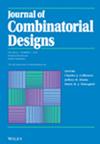经典仿射空间中最大全各向同性平面的Cameron–Liebler集
IF 0.8
4区 数学
Q3 MATHEMATICS
引用次数: 0
摘要
设A C G(2Γ,Fq)$ACG(2\nu,{\mathbb{F}}}_{q})$是q上参数为e$e$的2μ$2\nu$维经典仿射空间$q$元有限域Fq${\mathbb{F}}_,并且OΓ${\mathscr{O}}}_{\nu}$是A C G中所有最大全各向同性平面的集合(2Γ,Fq)$ACG(2\nu,{\mathbb{F}}}_{q})$。本文讨论了OΓ${\mathscr{O}}_{\nu}$中的Cameron–Liebler集,得到了几个等价的定义,并给出了一些分类结果。本文章由计算机程序翻译,如有差异,请以英文原文为准。
Cameron–Liebler sets for maximal totally isotropic flats in classical affine spaces
Let be the -dimensional classical affine space with parameter over a -element finite field , and be the set of all maximal totally isotropic flats in . In this paper, we discuss Cameron–Liebler sets in , obtain several equivalent definitions and present some classification results.
求助全文
通过发布文献求助,成功后即可免费获取论文全文。
去求助
来源期刊
CiteScore
1.60
自引率
14.30%
发文量
55
审稿时长
>12 weeks
期刊介绍:
The Journal of Combinatorial Designs is an international journal devoted to the timely publication of the most influential papers in the area of combinatorial design theory. All topics in design theory, and in which design theory has important applications, are covered, including:
block designs, t-designs, pairwise balanced designs and group divisible designs
Latin squares, quasigroups, and related algebras
computational methods in design theory
construction methods
applications in computer science, experimental design theory, and coding theory
graph decompositions, factorizations, and design-theoretic techniques in graph theory and extremal combinatorics
finite geometry and its relation with design theory.
algebraic aspects of design theory.
Researchers and scientists can depend on the Journal of Combinatorial Designs for the most recent developments in this rapidly growing field, and to provide a forum for both theoretical research and applications. All papers appearing in the Journal of Combinatorial Designs are carefully peer refereed.

 求助内容:
求助内容: 应助结果提醒方式:
应助结果提醒方式:


